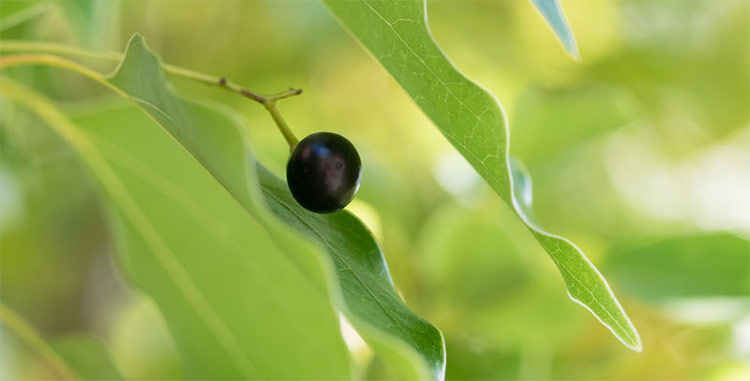Ravintsara Essential Oil
Cinnamomum camphora

Description
Also known as Ho Leaf Oil, Ravintsara Oil is often confused with Ravensara Oil or Ho Wood Oil. Ravintsara, Ravensara and Ho Wood oils are very different essential oils.
The aroma of Ravintsara Essential Oil is somewhat similar to Eucalyptus in some ways, but I find it to be greener. Aromatically, it blends especially well with Eucalyptus and oils in the wood, mint and citrus families.
Although Ravintsara Essential Oil is distilled from the leaves of the same plant that yields various camphor oils and crystals, camphor does not appear as a constituent within Essential Oil Safety or the various GC/MS reports that I've seen for the oil.

Emotionally, the oil shows a lot of promise for use in helping to focus in the midst of stressful situations and for helping to calm the nerves.
Although some sources suggest use of Ravintsara for viral and respiratory issues with children, it's important to heed Tisserand and Young's precautions (see Safety Information) below.
Ravintsara Essential Oil Benefits and Uses
- Influenza
- Shingles
- Supports the Immune System
- Stress
- Depression
- Calms the Nerves
- Promotes Sleep
- Muscular Aches and Pains
Source: Kurt Schnaubelt, Ph.D., The Healing Intelligence of Essential Oils (Rochester, VT: Healing Arts Press, 2011), 125, 142, 144, 178.
Botanical Name
Plant Family
Common Method of Extraction
Steam Distilled
Plant Part Typically Used
Color
Clear
Consistency
Thin
Perfumery Note
Top
Strength of Initial Aroma
Medium
Aromatic Description
Ravintsara Essential Oil smells fresh, earthy, eucalyptus-like with woody and subtle peppery notes.
Primary Constituents for Ravintsara Oil Originating From Madagascar
- 1,8-Cineole
- Sabinene
- a-Terpineol
- a-Pinene
- B-pinene
- Tisserand and Young report that oil sourced from China may contain Safrole and Methyleugenol.
See Essential Oil Safety for more complete list of typical constituents.
Source: L. Zhu, Y. Li, B. Li, et al. Aromatic Plants and Essential Constituents. (South China Institute of Botany, HK, 1993). J.C. Chalchat, I. Valada. Chemica Comosition of Leaf Oils of CInnamomum from Madagascar: C. zeylanicum Blume, C. camphora L., C. fragrans Baillon and C. angustifolium. (Journal of Essential Oil Research 12, 2000), 537-540. Sources cited in Robert Tisserand and Rodney Young, Essential Oil Safety (Second Edition. United Kingdom: Churchill Livingstone Elsevier, 2014), 304.
Ravintsara Essential Oil Safety Information
Tisserand and Young remind that "essential oils high in 1,8-cineole can cause CNS [central nervous system] and breathing problems in young children." They also caution not to use topically near the face of babies and children. [Robert Tisserand and Rodney Young, Essential Oil Safety (Second Edition. United Kingdom: Churchill Livingstone Elsevier, 2014), 304.]
General Safety Information
Do not take any oils internally and do not apply undiluted essential oils, absolutes, CO2s or other concentrated essences onto the skin without advanced essential oil knowledge or consultation from a qualified aromatherapy practitioner. For general dilution information, read AromaWeb's Guide to Diluting Essential Oils. If you are pregnant, epileptic, have liver damage, have cancer, or have any other medical problem, use oils only under the proper guidance of a qualified aromatherapy practitioner. Use extreme caution when using oils with children and be sure to first read the recommended dilution ratios for children. Consult a qualified aromatherapy practitioner before using oils with children, the elderly, if you have medical issues or are taking medications. Before using this or any essential oil, carefully read AromaWeb's Essential Oil Safety Information page. For in-depth information on oil safety issues, read Essential Oil Safety by Robert Tisserand and Rodney Young.
Shelf Life
Important Information About the Profiles
The essential oil information provided on AromaWeb is intended for basic educational purposes only. The references to safety information, test results, constituents and percentages is generalized information. Essential oils can vary greatly in composition. The data is not necessary complete and is not guaranteed to be accurate. The essential oil photos are intended to represent the typical and approximate color of each essential oil. However, essential oil composition and color can vary based on harvesting, distillation, age of the essential oil and other factors. Profiles for several CO2 Extracts and absolutes are included within the directory, and are denoted as such.
